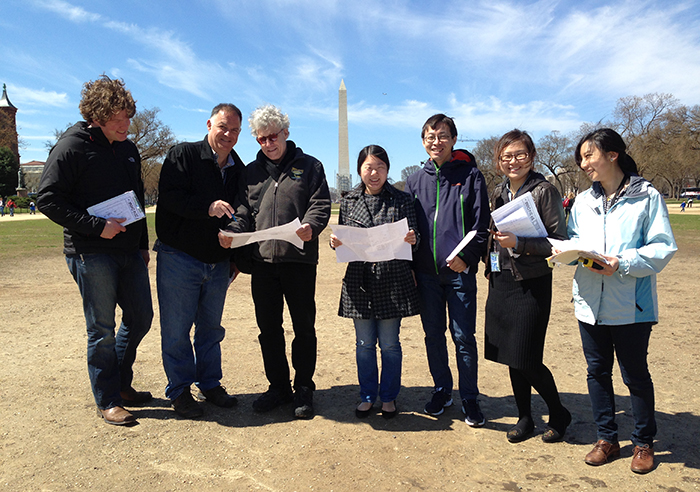In the summer of 2008, I was freshly out of graduate school and searching for professional approaches toward world cultures and cultural heritage issues. The search led me to Smithsonian Folkways Recordings—an internship that kick-started my career in the arts and has been guiding my work between different cultural and professional worlds ever since.
During my Folkways internship, I began to realize all the work that can be done to promote folk and traditional culture. I was fascinated by the Smithsonian Folklife Festival model, especially its multilateral cultural exchange. I told myself that if the Festival ever featured China, I would have to be involved. By the time they announced 2014’s China: Tradition and the Art of Living program, I had returned to China and been managing commercial theater productions at the China Performing Arts Agency for three years. Determined as I was, I was hired as China program coordinator.
I believe anyone who has interned or worked at the Center for Folklife and Cultural Heritage would agree that it is an inspiring place. But coming from a commercial theater world, I could see even more clearly what is so special about the Folklife Festival.
The biggest lesson I learned is that the Festival is all about the participants—the cultural bearers who present their traditions on the National Mall. Often times, they are not professional artists. They don’t have a book or blockings to follow. There’s no director to override their artistic decisions. All written and introductory materials are developed from their personal stories. Unlike professional theater, the producer does not rule here. The participants do.
From early 2014, I started accompanying the program curators conducting field research with possible participants in cities and villages all over China. We interviewed craftspeople, village medicine men, three generations of paper cutters, and traditional dancers and musicians—some with state-owned arts troupes and others with independent bands. By talking to the participants, we learned about their trades and how they passed them on.

We rely heavily on the participants to determine how the Festival will look. The fieldwork led to many international phone calls confirming every detail of presenting their cultures to the American public: which type of clay for the potter, what ingredients for each cooking demonstration, size of window frame to stick paper cuttings onto, and much more. The goal is to “restage” the participants’ usual working and living environments.
In commercial theater, the performance should be predictable. Actions and directions are best kept the same each night. The success of Broadway relies on these industrial standards of performance to run arts products as commodities.
After working in the commercial realm, the Festival was a humbling reminder that arts and cultures are organic, with a life of their own. It’s okay—and sometimes even necessary—to have things out of control. Even though we worked with the same group of participants during the two weeks of the program, they presented and created something new every day. It made me very nervous at first, but by the end I was grateful to see how new cultural understanding evolved within the Festival ecosystem.
In fact, some of the unpredictable moments were those I was most proud of. The first time I invited the Wu Opera’s dragon dancers to perform in our rather informal “People’s Park” area, the drummer thought I was crazy. After all, they are an award-winning state-owned troupe that has performed in theaters all over the world. But when the audience gathered around, packing the site, little kids clapping with the drumbeats, people applauding and whistling, I saw the drummer’s hesitation was replaced with a smile—matching that of the kid who was so curious about his drum. The flexibility of the Festival allows participants to break their routines.

One similarity between the Festival and formal theater is that they both require teamwork and production management. In theater, usually more staff than cast are needed to accomplish a performance. The Festival also has a thorough net of support. Apart from curators and administrative staff, it relies a great deal on volunteers, interns, a full team of tech crew, supply system, and design team. Together they make sure the Festival is beautiful, culturally appropriate, and properly functioning. More than one hundred people worked on the China program. They are the reason why, when the Festival opened, I felt somebody had cast a magical spell on the site, because everything seemed to be working on its own.
Theaters provide a stage for artists of profession, and the Folklife Festival for artists of life. Working at the Festival was a memorable experience in learning from each other, building friendships, and creating love for another culture. Now I am back in China, working at an arts center that organizes festivals throughout the year. I will always keep in mind the drummer who stepped out of his comfort zone to perform at People’s Park. Hopefully, we too will be able to create an environment for artists and audiences to step out and create new levels of mutual understanding and appreciation.
Jing Li was a Smithsonian Folkways intern in 2008 and the program coordinator for China: Tradition and the Art of Living at the 2014 Folklife Festival. She is currently working at Beijing Tianqiao Performing Arts Center as deputy general manager, overseeing content operation.


